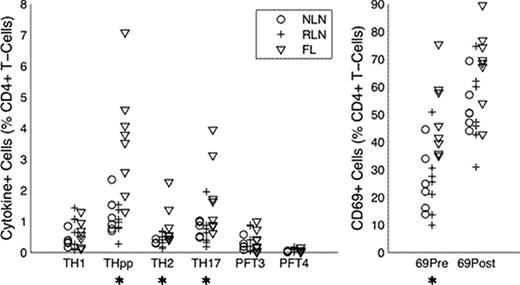Abstract
Abstract 3119
Tumor infiltrating T-cells tend to be hypo-functional and this loss of function may be due to intrinsic T-cell defects, impaired antigen (Ag) presentation, and/or suppression induced by extrinsic components of the microenvironment, such as regulatory T-cells (Tregs). Each of these potential mechanisms has distinct implications on the potential efficacy of immunotherapy. To determine the functional potential of follicular lymphoma (FL) derived T-cells, we analyzed, by flow cytometry, T helper (Th) subsets and Staphylococcus enterotoxin B (SEB)-induced cytokine profiles of single cell suspensions from FL involved nodes (FL; n=8), reactive lymph nodes (RLN; n=7) and normal lymph nodes (NLN; n=6; obtained during vascular surgery). SEB was used as it directly triggers the T-cell receptor, abrogating the need for Ag presentation, and overcomes Treg mediated suppression. Herein we show that, relative to NLN, FL has decreased proportions of CD4+ T-cells having either a naïve (CD45RA+) or central memory (CD45RA−CCR7+) phenotype but increased proportions of effector memory T-cells (CD45RA−CCR7−). In addition, a higher percentage of pre-stimulation FL CD4+ T-cells show an activated (CD69+) phenotype as compared to that of RLN or NLN. Upon SEB stimulation, the FL CD4+ T-cells, like those from RLN and NLN, show an additional increase in the proportion of CD69+ cells, demonstrating that the FL derived CD4+ T-cells can be activated even further. We also show that upon stimulation with SEB; (a) the proportion of Th1 cells (IL-2+IFN-g+IL-4−) in FL is similar to that seen in RLN or NLN; (b) in contrast, we observe an increased frequency of primed uncommitted precursor Thpp cells (IL-2+IFN-g−IL-4−) in FL compared to that seen in either RLN or NLN; (c) an increased proportion of Th2 cells in FL compared with NLN and; (d) an increase in the proportion of Th17 cells in FL compared to that in RLN. Lastly, the proportions of FL Th cells producing 3 or 4 cytokines simultaneously, or poly-functional CD4+ T-cells, (PFT; PFT-3 producing IL-2, IFN-g and TNF-a or PFT-4 producing IL-2, IFN-g, TNF-a and MIP-1b), after SEB stimulation is similar to that seen in RLN or NLN. These data suggest that although there is skewed Th cell differentiation in FL, as compared to that of RLN or NLN, the intrinsic ability of the FL Th cells to elicit a clinically relevant effector response (both a Th1 and Th2 response) is fully preserved. In addition, the retention of effector function of FL Th cells is further supported by the fact that the proportions of these Th cells that have poly-functional cytokine profiles after SEB stimulation is similar in FL as compared to RLN or NLN. Indeed, poly-functionality of Th cells has been shown to correlate with the elicitation of protective immunity after vaccination for infectious diseases. Finally, the proportion of uncommitted Thpp cells after SEB stimulation is highest in FL. Thpp cells are non-polarized and can still differentiate into either Th1 or Th2 cells. They can also produce several chemokines and thus may play a role in shaping the FL microenvironment by recruiting other immune-effector cells as well as developing into Th1 and Th2 cells. Taken together, our data shows that FL Th cells are fully functional within the parameters of our assays, suggesting that these cells are intrinsically capable of mediating effective anti-tumor immune responses after immunotherapy. Therefore the hypo-functionality of FL T-cells is likely due to extrinsic factors which suppress T-cell function in vivo. Thus the challenge is to develop immunotherapeutic strategies that overcome these tumor associated extrinsic mechanisms, resulting in effective anti-tumor immunity.
No relevant conflicts of interest to declare.
Author notes
Asterisk with author names denotes non-ASH members.


This feature is available to Subscribers Only
Sign In or Create an Account Close Modal